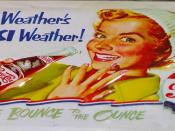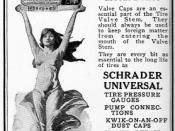Popular shows and ads try to lure audiences by showing sexually revealing images of women. Women in such commercials are portrayed as not women, but as sexual objects. Commercials that air during TRL routinely use women as objects in order to sell a product. Female bodies are used in order to sell specific products. (Grey, 2002)A controversial Brittany Spear's commercial is aired in during the TRL music hour. This specific commercial's goal is to sell Pepsi. Brittany Spears is a pop music singer who is recognized for her sexually revealing body. This commercial shows Spears as a sexual icon that is obviously attractive to all the men watching. The advertisers of this commercial know that SpearÃÂs commercial/video has an emphasis her large chest and slim stomach. This strategy sells more than the Pepsi product. It first sells SpearÃÂs body. Ads, such as these, show that girls are supposed to be an ideal body type.
Even more, commercials like SpearÃÂs show women to be objects for male pleasure. (Grey, 2002)Another commercial that sparked interest within this TRL hour was Venus female razor advertisement. This commercial used a method that appealed to the people watching (especially girls) that in order for them to feel like a goddess they had to shave their legs with this product. During the commercial I see nothing but legs.
The legs shown are very attractive. There are women attached to these legs, but the audience never sees their faces. The numerous leggy and faceless bodies all look the same. Repeatedly the legs are shown in different positions. There is only the focus on women, legs.
Again, women are not seen a people but as objects. This advertisement offers the notion that women do not have to be seen as themselves, but what items. "IÃÂm your Venus, IÃÂm your fire, your desire" is what is continually played so that the underlying message of male acceptance can be picked up on. As women, we are picked apart and then told that our body needs grooming so more objectification could occur. (Grey, 2002)Most television advertising creates a stereotype that appeal to the opposite genderÃÂs needs and desires. Viewers are frequently invited to objectify females. It is an invisible and largely unquestioned bias. The masculine perspective is the norm. This works because men are the dominant executives and advertisements producers. And, it is mainly men for who ads are targeted for. The women that are extremely beautiful and sexually attractive are the ones who are featured as the objects for men. In these commercials and many more, the focus is on women to "prance" around as a toy of men. Upon viewing images such as these, women can feel dehumanized. This is not because they are dehumanized but because they no longer see themselves as people in the eyes of the public. Many women have already accepted the norms for women. Apparently the norm is women are no longer humans with a mind, but are things. As women are dehumanized, men see women as objects as well. Men will treat women as if they are objects, just as ads encourage. (Grey, 2002)ReferencesGrey, Judith. 2002. Marketing the Gender Differences on television advertising. The Sun Tabloid (UK) Nov. 22.





